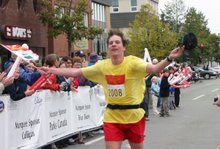
http://www.theguardian.pe.ca/Sports/2011-10-11/article-2774347/On-the-Run%3A-Time-for-final-preparations/1
On the Run: Time for final preparations
In this article, we will look at the final few days of preparation, a few race day considerations and last, but just as important as your training, post race recovery.Before we look at these items, let’s take a quick look at some important road closures. For a more comprehensive list of the closers, please check out the P.E.I. Marathon website. Marathon weekend is Oct. 14-16.
For those planning to take their own transportation to the National Park, please note. The westbound (waterside) lane of the Gulf Shore Parkway will be closed to traffic from Dalvay to Brackley beginning at 7:30 a.m. until the last runner exits the park. The Sherwood Road is closed to all traffic from 9 a.m. to 2 p.m. There are a number of parking restrictions for the streets surrounding the marathon finish line. For other important information please refer to the Island marathon website.
This is it, the week you all have been working towards, months of training are now behind you. I hope you enjoyed the journey to get to this point in your training. In these last few days you will probably do a few short runs or walks to keep your self loose. You maybe are getting a little nervous and jittery thinking about your upcoming run.
I like to think this is all normal, a good sign that you are probably ready to go. To help combat the nerves it may be a great time to catch up on some reading, a movie or two or doing something you enjoy doing that doesn’t use to much physical energy. You should try to conserve that energy for race day. Take the time to reflect on your training, what worked for you and what might not have worked so well. It would also be a great time to think about creating your race day checklist. This list should contain everything you will need for race day — such as articles of clothing, shoes you may be planning to use, food requirements for the day, equipment and gear such as fuel belts, anti chafing cream, watches, GPS, music, etc. Above all, don’t forget your timing chip. If you plan to use gels, energy bars or other packaged foods, please take along a baggie to store the wrappings to prevent littering on the course.
Race Day
Be sure to take lots of time to get yourself to your race start.
The areas around the race start and finish lines will be congested and will take a little longer to get there. Other things to consider are some warm clothing to wear, both before and to change into after the run, especially those travelling to the marathon and relay start point. Just before the race, start putting this clothing back on the bus to take it back to the finish line. Please attach the tag that will come with your bib number to your bag, so you will be able to retrieve it at marathon headquarters afterwards. The race starts are very exciting places. You will be mingling with other runners of all abilities and people running different distances. Enjoy the excitement but, as a word of caution, once the race begins be sure you stick to your pace and run your race. It is very easy to get caught up in the excitement and leave much faster than you may have planned. From my own experience, I find if I loose my breath before I get into my running rhythm, I find it very difficult to get it back.
All along the course you will see all kinds of volunteers, manning the water stops, directing traffic and runners, first aid, music, etc. There are many more you will not see who have work tirelessly in the background to help stage this event. All these folks are giving you their time freely. Please take the time to acknowledge and thank them.
Post Race
After your race, you should expect to be a little stiff and maybe sore and you could feel a little let down emotionally. This is normal for many runners. After all, this has been your focus for many weeks. To help with your recuperation, you should also be considering a post race recovery period, especially those running the longer distances. Depending on your fitness level and upcoming running goals, a post race period should include at least the following.
Nutrition: Eat a balanced diet. Your body will need carbs, proteins and nutrients to rebuild damaged muscles. Do not resume a weight loss diet you may be considering until after the first week. If you have cravings, indulge them moderately. Your body may be telling you what it is missing.
Sleep: Your body builds muscle and repairs itself while sleeping. Get lots of additional rest and sleep after your run.
Loosen up period: Combine minimal, easy running with walking and other forms of cross-training, such as easy cycling, spinning, swimming or water running that will improve blood flow to your legs.
Good luck to all participants. I hope each of you will accomplish the goals you have set out for yourself. Above all have fun and enjoy the day?
Doug MacEachern is chair of course logistics for the BMO Nesbitt Burns P.E.I. Marathon, Oct. 14 to 16. For questions about training, contact him at info@princeedwardislandmarathon.com.




























































